Lanzones (Lansium domesticum) is grown throughout the entire Southeast Asian region, ranging from Southern India to the Philippines for its fruit. It is a seasonal crop so it produces fruits only in late September through early November and the rest of the year you wait.
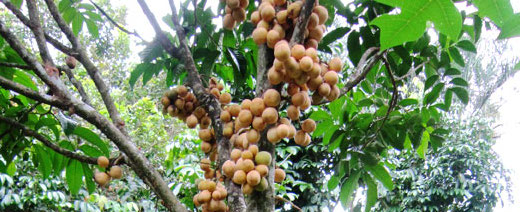
The tree is erect, short-trunked, slender or spreading; reaching 35 to 50 ft (10.5 to 15 m) in height, with red-brown or yellow-brown, furrowed bark. Its leaves are pinnate, 9 to 20 in (22.5-50 cm) long, with 5 to 7 alternate leaflets, obovate or elliptic-oblong, pointed at both ends, 2 3/4 to 8 in (7-20 cm) long, slightly leathery, dark-green and glossy on the upper surface, paler and dull beneath, and with prominent midrib. Small, white or pale-yellow, fleshy, mostly bisexual, flowers are home in simple or branched racemes which may be solitary or in hairy clusters on the trunk and oldest branches, at first standing erect and finally pendant, and 4 to 12 in (10-30 cm) in length.
Lanzones fruits are ovoid, roundish orbs around five centimeters in diameter, usually found in clusters of two to thirty fruits along the branches and trunk. Each round fruit is covered by yellowish, thick, leathery skin. Underneath the skin, the fruit is divided into five or six slices of translucent, juicy flesh. The flesh is slightly acidic in taste, although ripe specimens are sweeter. The sweet juicy flesh contains sucrose, fructose, and glucose. They are usually eaten fresh, but may be canned in syrup. Seedless sections can be dried like raisins, which is done in the Philippines. Lanzones is rich in carbohydrate, calcium, phosphorous, thiamine, riboflavin, niacin and vitamin C.
Lansium domesticaton occurs in at least four cultivated forms, namely, duku, langsat (lansones), duku langsat and dokong. They differ in tree form, fruit and in fruit arrangement. A typical langsat fruit is borne in clusters of 6-10. An individual fruit is round or oval in shape, about 2.5 – 3.0cm long with a comparatively thin skin. The skin exudes latex even when it is mature. Its flesh is divided into 4 – 5 segments. Only one segment contains large, green bitter seed while others contain small seeds or are seedless. Its taste varies from sour, slightly sour to sweet. he duku fruit is round, from 2.5 – 5.0cm in diameter with a thick (6mm) dark coloured skin more leathery than duku langsat and langsat.
There are usually 4 – 12 fruits per raceme. The duku langsat fruit resembles that of langsat in shape and colour except that it has a thicker skin. There are usually 5 – 25 fruits per raceme. The fruit is round or oval in shape and from 2 – 4cm in diameter. Like the langsat and duku the skin of duku langsat peels easily from the aril. In duku and duku langsat the flavour is generally very delicate and sweet. Duku langsat is native to Malaysia, Phillippines and Java where it is widely distributed. The Dokong is quite similar to the other lansium, fruit is aborate, flavour is sweet and a little samrish taste, the texture is soft and juicy. It is less asomatic compared to the other 2 lansium.
There are two distinct botanical varieties: 1) L. domesticum var. pubescens, the typical wild langsat which is a rather slender, open tree with hairy branchlets and nearly round, thick-skinned fruits having much milky latex; 2) var. domesticum, called the duku, doekoe, or dookoo, which is a more robust tree, broad-topped and densely foliaged with conspicuously-veined leaflets; the fruits, borne few to a cluster, are oblong-ovoid or ellipsoid, with thin, brownish skin, only faintly aromatic and containing little or no milky latex. The former is often referred to as the “wild” type but both varieties are cultivated and show considerable range of form, size and quality.
There are desirable types in both groups. Some small fruits are completely seedless and fairly sweet. ‘Conception’ is a sweet cultivar from the Philippines; ‘Uttaradit’ is a popular selection in Thailand; ‘Paete’ is a leading cultivar in the Philippines. The langsat is ultra-tropical. Even in its native territory it cannot be grown at an altitude over 2,100 to 2,500 ft (650-750 m). It needs a humid atmosphere, plenty of moisture and will not tolerate long dry seasons. Some shade is beneficial especially during the early years.
Langsats are commonly grown from seeds which must be planted within 1 or 2 days after removal from the fruit. Viability is totally lost in 8 days unless the seeds are stored in polyethylene bags at 39.2º-42.8º F (4º-6º C) where they will remain viable for 14 days. Seedlings will bear in 12 to 20 years. Air-layering is discouraging, as the root system is weak and the survival rate is poor after planting out. Shield-budding has a low rate of success. Cleft- and side-grafting and approach-grafting give good results.
The budwood should be mature but not old, 2 1/2 to 3 1/2 in (6.5-9 cm) long, 1/4 to 3/4 in (6-20 mm) thick, and it is joined to rootstock of the same diameter about 2 1/2 to 4 in (6.5-10 cm) above the soil. Some preliminary experiments have been conducted in Puerto Rico with hormone-treated cuttings under intermittent mist. Whitman found that a potted cutting 3 to 4 in (7.5-10 cm) long, will root if covered with a clear plastic bag.
Lanzones Varieties
Duku
– The tree is usually shorter than the other varieties but has a wider crown.
– Leaves are hairless.
– Fruits are round and are borne from 4 to 12 fruits per raceme.
– Pericarp is thick (up to 6 mm) with no latex.
– It is sweet with a delectable flavor.
Paete
– Grown mostly in Luzon, Misamis Oriental and Camiguin Island.
– Fruit is elongated and smallest among the varieties.
– Leaves are lanceolate.
– The tree is erect.
– Trees are relatively susceptible to bark borer infestation.
Longkong
– A variety introduced from Thailand and Indonesia.
– The fruit is sweet and tasty.
– Almost seedless.
– The skin or peel has no latex.
Cultural Management
Site Selection
– Flat to hilly within 600 m above sea level.
– The land should have a loamy or sandy soil.
– 2,500 – 3,000 mm annual rainfall
– 75-80% relative
Preparation of Planting Materials
Asexual Propagation, Grafted Lanzones
Lanzones may be propagated sexually by seeds and asexually by cleft grafting. Propagation by seeds has been practiced since earliest times. In fact, most bearing and non-bearing lanzones trees in the Philippines have been propagated by this method. Many farmers claimed that seed propagation is better than asexual methods since the latter do not offer any additional advantage. This claim may be partly true in the sense that lanzones seed is apomictic and the resulting plants being part of the maternal tissue of the seed would inherit the same qualities of the mother tree. However, one main disadvantage of plants grown from seeds is the much longer waiting time (about 15 years) before the trees flower and bear fruits.
For this reason alone, the use of asexually propagated planting materials appears to be the best alternative option. Propagation by cleft grafting is the best and most widely used asexual method. The scions used are straight, terminal, well mature and non-petioled shoots about 1 cm in diameter and cut 10-15 cm long. Seedling rootstocks are usually ready for cleft grafting when they are about 1-1.5 years old or when their stems have reached the diameter of a pencil.
Cleft grafting is best done during rainy season. Studies have shown that success is about 77% during the wet season and only about 50% during the dry season. Grafted plants begin to bear fruits 7 years after planting (Coronel, 1992).
Seed Preparation and Germination
1. Select seeds from desirable mother trees that are heavy bearers of sweet fruits.
2. Clean seeds by removing the mucilage and thoroughly wash in running water.
3. Sow the seeds in seedbeds containing fine and sandy soils 3-5 cm apart, about 1 cm deep. It will germinate after 2-3 weeks.
4. Do not store seeds for long time. Delay sowing will cause low germination percentage.
5. However, in case sowing will be delayed, air dry the seeds, place in polybags store up to 14 days in the refrigerator at 4-6oC.
Transplanting and Care of Lanzones Seedlings
1. Because seeds are polyembryonic which produce 2 or more seedlings per seed, wait until the seeds have at least a pair of mature leaves before transplanting.
2. Separate the seedlings when they have their own root systems and transplant individually.
3. Transplant the seedlings in polybags containing soil media composed of garden soil and compost. Plant in nursery rows with a space of 30-50 apart.
4. Keep the newly transplanted seedlings under partial shade.
5. Apply nitrogen and phosphorous fertilizer for proper growth and development.
6. Water seedlings regularly especially during dry months.
Land Preparation
1. For backyard planting, dig a hole wide and deep enough to accommodate the plant with a ball of soil.
2. For medium to large scale planting, prepare the land thoroughly.
3. For second growth forest, trees are cut down, and burn the trees as they dry. Leave the stumps to decay and plant without plowing.
4. In open land and under coconut, do the deep plowing to loosen the soil followed by harrowing.
5. As soon as the land is ready, make a stake a distance 5-7 meters. Under the coconut, set the stakes at the center of the squares formed by the coconut trees. Since coconut trees are usually spaced 8 m apart, the resulting distance for lanzones is also 8 meters.
6. Dig holes at the positions previously occupied by the stakes.
Planting
1. Set the plants in the field, in polybags or balled from nursery rows. Prune the leaves to reduce transpiration.
2. Plant at the onset of rainy season or when irrigation water is available.
3. Cover the bases of seedlings with topsoil mixed with compost and pack gently for better anchorage.
Shading
Provide the newly planted seedlings in the open field with banana leaves of coconut fronds to protect them from sunlight, or plant madre de cacao and ipil-ipil between lanzones trees. Prune shade trees regularly as this will cause the lanzones trees to grow lanky and tall. Under coconut, it is not necessary to provide additional shade since the trees grow satisfactorily in partial shade.
Fertilization
During the first year, apply about 400g ammonium sulfate per tree, apply in 2 installments, one month after planting and before the end of the rainy season. As the plants grow bigger, correspondingly increase the amount of fertilizer to be applied each year. At fruiting stage, trees need additional phosphorous and potassium. Apply one kg of complete fertilizer per tree during the first year of fruiting. Increase the amount every year as the tree grows older and bigger and as the fruit yield increases. At the peak of fruiting, an annual application of at least 2 kg complete fertilizer per tree may be required.
Fertilization Table:
| Plant Age/Stage | Kind of Fertilizer | Rate/Plant |
| a) Vegetative stage | Ammonium Sulfate (21-0-0) or Urea (46-0-0) | 100-200 gm/ tree/year |
| b) Bearing stage | Complete Fertilizer (14-14-14) | 5-8 kgs/tree/year (after harvest) |
Irrigation
Water the newly planted seedlings regularly, and provide irrigation to the bearing trees to induce flowering. Irrigation, however, induces flowering only when preceded by a 6-8 weeks water shortage. Sustained water supply is necessary in an orchard, otherwise the flowers and fruits will not develop well. Provide it with an adequate water during summer months.
Pruning
Lanzones trees specially “Paete” variety tend to grow erect. Train the young plants to increase a spreading growth habit of the trees. Cut the top about ~ meter from the ground. This practice forces the growth of lateral branches to come out below the cut. Allow only 2 to 3 well spaced branches to develop and remove the rest. Spreading branches tend to have more bearing surfaces, facilitate harvesting of fruits and control bark borers. Remove also the watersprouts, infested and dead branches and those with clinging parasitic plants. Since lanzones has a cauliflorous fruiting habit (borne on trunk and large branches), it is advisable to remove small, unproductive branches in the interior of the tree.
Flower thinning
Remove excess cluster of flowers that emerge in tertiary and small branches, short clusters (less than 3 inches) and overcrowded clusters to prevent deformities in fruits.
Clearing/Ring Weeding
Intercropping and Covercropping
Lanzones is a good intercrop under coconut in the Philippines. Ring weed and cultivate in the area at least twice a year during the early life of the plant. In an open area, short-season crops can be grown between rows of lanzones to give additional income. When it is not economical anymore, covercrops are used such as colopogonium, and Tropical Kudzu. When irrigation facilities are not available in the orchard, employ mulching around the tree to conserve moisture and to add to the organic matter when decomposed.
Pest Management In Lanzones
Pests and Diseases
- threat to the industry
- retard the growth of trees
- reduced both quality and quantity
- reduce yield
Insects Pests of Lanzones
1. Bark Borer
- Serious pest of lanzones
- Bark infestation suppresses flower emergence and reduces yield
a. Proxinonena sp.
- Injurious among species
- Feeds on bark and cambium layer
- Produce a scaly bark
b. Cossus sp.
- Mines under the bark by feeding on it and secretes a web that form a tunnel.
- Infestation occurs at the crevices between branches.
- Infestation in old trees.
c. Gold-banded Moth
- Larvae predominant on the terminal twigs.
- Dark blister-like appearance indicative of its infestation.
- It penetrates the cambium layer of the twigs.
- Scraping-off of infested bark is harder than Proxinonena sp.
2. Twig Borer (Cerambycid Beetle) – The larva bore into the stem or twig of the lanzones trees resulting in the death of plant tissue. To Control, damage plant parts must be pruned and burned.
Pest Control
1. Mechanical Method – Scraping and pruning infested portions.
2. Chemical Method – Application of insecticide after mechanical operations in knocking out the borer.
Lanzones Diseases
1. Root Rot
- This fungus disease attacks trees in areas with waterlogged condition.
- Infection starts at lateral roots and moves towards the main root up to the base of the trunk.
- Externally the leaves turn yellow and gradually fall-off.
Control:
- Provide good drainage
- Digging and burning of dead trees
- Treat infected roots and trunk with fungicides
2. Scab
- Serious disease affecting the Longkong variety of lanzones.
- Exhibited by bulging of the bark.
Control: Spray Copper Hydroxide(Kocide) or Copper Oxychloride)
Harvesting
- Harvest the fruits 140-150 days from flower formation to fruit ripening. Do the harvesting early in the morning or late in the afternoon.
- Fruiting and harvesting season in Mindanao is from July to November. Off-season fruiting is from January to April. Lanzones has an alternate bearing habit. Harvest when the fruits are fully mature, have turned full straw yellow in color, usually in bunch. Fruits clipped-off in bunches with a pruning shear or knife by climbing the tree with the use of ladder. Pack the fruits in kaings or cartons lined with newspaper, dried leaves or foam.
Post Harvest Handling
- sort, clean, air dry and grade the harvested fruits.
- pack the fruits in cartons or crates with liners or cushion to reduce damage during handling.
- store the fruits in cold storage at 10°C with relative humidity of 85-90 % to extend the shelf-life of the harvested fruits.
Lanzones is highly perishable. Under ordinary room conditions, fruits remain marketable for not more than 4 days. Fruits treated with 0.7% Benlate fungicide store best at 590oF and at 85-90% R.H. Fruits can be preserved by freezing. Seedless segments are placed in 70% syrups, frozen at 400oF and stored at 180oF and it can also be canned in syrup and juice may also be used as a beverage base or made into syrup and jelly.
Source: pcarrd.dost.gov.ph
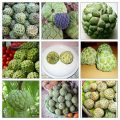

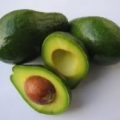
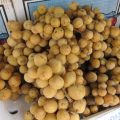
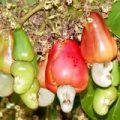
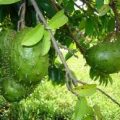

I really love Duku and this is a very good site of information about farming. Keep up the good work
FANTASTIC
where can i order this tree? to mail in USA
thanks for the useful info. i've just bought 2 variety of lanzones duku and longkong. is it possible to be grown at isabela province?
very useful info. planting some in tanay this rainy season…
the Duku variety is my favorite. for additional information about farming please check our website,
http//:farmingeek.org
thanks!